Beautiful Birmingham Terracotta
Discovering Birmingham’s extensive collection of beautiful terracotta buildings.
Red, bold, ornate and beautiful…these are some of the words which spring to my mind when I see the striking Victoria Law Courts on Corporation Street built in 1891. For me, it is the material which provides the stunning architectural beauty of this particular building and many other similar terracotta buildings across the city such as the Methodist Central Hall opposite (1904). Terracotta was a popular building material during the late Victorian era especially as a cheaper substitute for stone and was used for many large civic buildings. It is a material which is very much associated with the arts & crafts movement and could be carved into many intricate shapes and forms.
Different types of clay produce different colour variations of terracotta. The deep red colour predominantly used in Birmingham is made from clay sourced from North Wales whereas Buff Terracotta is from south-east England. Even though the majority of these buildings are over 100 years old, the terracotta is still a vibrant and impressive material. The Law Courts and Methodist Central Hall are the two most well-known examples in the city centre but there are plenty of other stunning buildings in the vicinity which use this material
Within the city centre there is the former Bell Edison Telephone Building (1896); a gorgeously ornate building standing proud on the corner of Newhall Street and Edmund Street. The vibrancy of the red and the ornately carved terracotta really make this building something special.
One of my personal favourites is the mystical looking ‘Red Palace’ (1896) on the end of Constitution Hill. It is a wedge shaped building with an ornate tower on the corner which is a memorial to Lord Roberts of Kandahar. The tower reminds me of something out of a Brothers Grimm fairytale; perhaps Rapunzel is trapped up there! There are also some red terracotta buildings on Bristol Street (no’s 74-79), one block of which has been recently refurbished into new student accommodation after standing vacant for some time.
As well as red terracotta there are also some interesting buff terracotta buildings in the city such as the frontage of the former Queens College Chambers on Paradise Street (1904).
The buildings discussed so far are examples where the majority of the building or façade is formed out of architectural terracotta, which contributes not only to the appearance of the building but structurally as well. Due to its plasticity, terracotta was also a good material to mould into decorative window heads, sills and banding as well as providing rich sculptural relief to a façade. Such detailing can be found in both red, buff and orange shades of terracotta.
There are also plenty of examples of red brick buildings with significant terracotta detailing such as the School of Art on Margaret Street (1881) and the Ikon Gallery (Originally the Oozells Street Board School- 1877) in Brindley Place both by English architects Martin & Chamberlain. Martin & Chamberlain were responsible for many of the red brick and terracotta buildings in the city during the Victorian era, including the Victorian Board Schools. Also Martin’s son Frederick followed his father’s occupation and designed the Bell Edison Exchange discussed earlier.
Many public libraries built during the Victorian era were also constructed out of red brick and terracotta such as the Springhill Library on Icknield Street (1893) (again by Martin & Chamberlain) and on the outskirts of the city centre there is the Gothic Bloomsbury Library in Nechells (1892). There are also a number of buildings around Newhall Street with buff & red terracotta detailing especially on Edmund St, Cornwall St & Church St.
One of the problems with buff and red terracotta was that it did tend to blacken over time due to smoke and pollution in the city air which was difficult to clean off. A later variation was glazed terracotta also known as ‘faïence’ which is available in glazed brick blocks or tiles. Faïence was easier to clean and also available in a wider variety of colours which was perfect for decorative detailing. Like terracotta it is formed out of ground clay so can be moulded into any shape. An example of faïence used for decorative purposes can be found on the ornate grade II listed frontage of the Trocadero Pub on Temple Street (1902). White faïence was also used on the frontage of Piccadilly Arcade on New Street (1910 & 1926) which is clad in square glazed tiles with green faïence ribbon banding across the recessed arch above the entrance.
Architectural terracotta was not only a popular material for large civic buildings such as the Law Courts but it was also used on many public houses throughout the city. James and Lister Lea was an architectural firm well recognised for designing pubs across Birmingham during the late 19th to early 20th century; and many of their pubs use terracotta as the main material. The Anchor Inn (1901) and The White Swan (1900) are two quintessentially Victorian street corner pubs located on Bradford Street in Digbeth which have both red terracotta and brickwork façades. Other James and Lister Lea terracotta pubs include The Woodman (1897), Swan and Mitre (1899), The Market Tavern (1900), The City Tavern (1901) and The Red Lion (1902). The use of terracotta in pub architecture seems to be in most cases reserved for the ground floor pub frontage perhaps as a way of making these buildings stand out and attracting customers.
The use of terracotta declined at the beginning of the 20th century to make way for new building materials such as concrete and steel. The extremely ornate High Victorian style with elaborate terracotta detailing gave way to a simplified modern style, though faïence was still used in the 1920’s for Art Deco buildings such as cinemas.
To be honest each of the buildings mentioned above are so stunning that they deserve a blog post each in their own right! Luckily the majority of them are statutory listed or at least locally listed so their architectural worth has been recognised and will hopefully be preserved for generations to come.
Writing this blog post has made me realise that Birmingham certainly does have an extensive number of noteworthy terracotta buildings, far more than I initially realised. The photos above shown a small selection of the terracotta delights the city has to offer, but there are many more. Below is a list of some of the most well-known examples within the city.
Do you know of any other good examples of terracotta architecture in the Midlands? – I would love to hear from you.
City Centre:
Corporation Street:
- The Victoria Law Courts (1881)- By Aston Webb & Ingress Bell-Grade I listed- red terracotta
- Methodist Central Hall (1904)- By Ewan Harper & James A. Harper- Grade II* listed- red terracotta
- Ruskin Buildings (1899)- By Ewan Harper- Grade II listed- red brick & buff terracotta
- Murdoch & Pitman Chambers (1897)- By Crouch & Butler- Grade II* listed- brick & buff terracotta
- Coleridge Chambers (1904)- Grade II listed- terracotta detailing
- No 190 (1891)- By W.H Ward- red brick/terracotta
New Street:
- No’s 41-42a Newton Chambers (1899)- By Essex, Goodman & Nicol- Grade II listed- buff & red terracotta detailing
- No 71 (1912)- By Crouch Butler & Savade- white faïence cladding
- Piccadilly Arcade (1909)- By Nicol & Nicol-white faïence cladding
- No’s 112-113 (1914)- By Crouch, Butler & Savage- white faïence cladding
Union Street:
- City Arcade (1901)- By Newton & Cheatle- Grade II* listed- terracotta cladding
Waterloo Street:
- No 44 (1900)- By Mansell & Mansell- Grade II* listed- buff terracotta detailing
Newhall Street:
- No’s 17-19 Bell Edison Telephone Building (1896) -By Frederick Martin- Grade I listed- red terracotta
- No’s 43-51 (1896)- By F.B. Osborne- Grade II listed- buff terracotta detailing
- No’s 50 & 52 (1896) By Essex & Goodman- Grade II listed- terracotta detailing
- No’s 56-60 (1900) By Newton & Cheatle- Grade II* listed- terracotta detailing
Edmund Street:
- No 134 (1897) By Newton & Cheatle- Grade II listed- terracotta detailing.
Cornwall & Church Street:
- The Old Royal Public House (1898)- By A.H.Hamblin- Grade II listed- buff terracotta detailing
Margaret Street:
- Birmingham School of Art (1885)- Martin & Chamberlain- Grade I listed- red brick/terracotta
Brindley Place:
- Ikon Gallery/Oozells St Board School (1877)- Martin & Chamberlain- red brick/terracotta
Bristol Street/ Suffolk Street Queensway:
- No’s 74-79– Bristol Street- red brick/terracotta
- No 128- Suffolk Street Queensway- red brick/terracotta
Steelhouse Lane:
- Birmingham Children’s Hospital-(Steelhouse Lane Building- Formerly Birmingham General Hospital)-Locally Listed- red brick/terracotta
Hockley/ Jewellery Quarter
Constitution Street:
- The ‘Red Palace‘/ former H.B. Sale factory (1896)- William Doubleday and James R. Shaw- red terracotta
Icknield Street:
- Springhill Library (1882)- Martin & Chamberlain- Grade II* listed- red brick/terracotta
Suburbia:
- Bloomsbury Library (1893)- Nechells Parkway, Nechells- Grade II Listed red brick/terracotta
- Aston Cross Library – Lichfield Road, Aston- red brick/terracotta
- Green Lane Mosque (1902) (formerly Green Lane Public Library and Baths) –Green Lane, Small Heath- By Martin & Chamberlain- Grade II listed- red brick/terracotta
Terracotta Pubs:
James and Lister Lea:
- The Anchor Inn (1901)-Bradford Street, Digbeth- Grade II listed -red brick/terracotta
- The White Swan (1900)- Bradford Street, Digbeth- Grade II listed -red brick/terracotta
- The Woodman (1897)- Albert Street, Digbeth- Grade II listed -red brick/terracotta
- Swan and Mitre (1899)- Lichfield Road, Aston- Grade II listed -red brick/terracotta
- The Market Tavern (1900)- Moseley Street, Digbeth- Grade II listed -red brick/terracotta
- The City Tavern (1901)- Bishopsgate Street, Ladywood- Grade II listed -red brick/terracotta
- The Red Lion (1902) –Soho Road- Grade II* listed- Red & buff terracotta frontage
- Marlborough Public House(1900)- Anderton Road, Sparkbrook- Grade II listed -red brick/terracotta
Others:
- Aston Cross Tavern– Lichfield Road, Aston- red brick/terracotta
- Shannons- Bordesley Green- red brick/terracotta
More pictures available on my Flickr page where I will be collating a comprehensive range of Brum Terracotta photographs : Terracotta Birmingham Photo Album


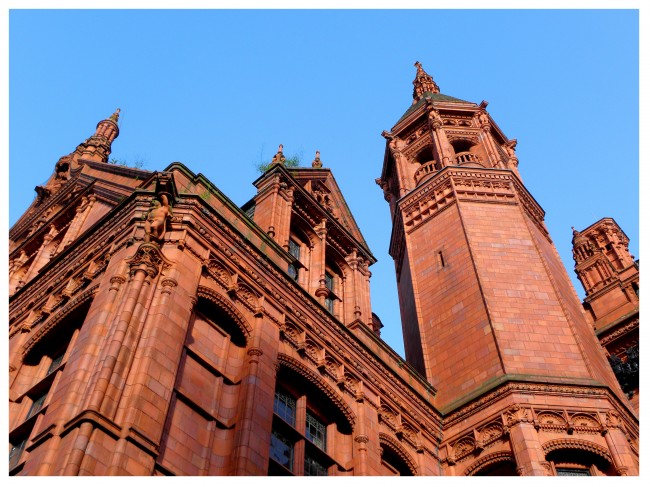
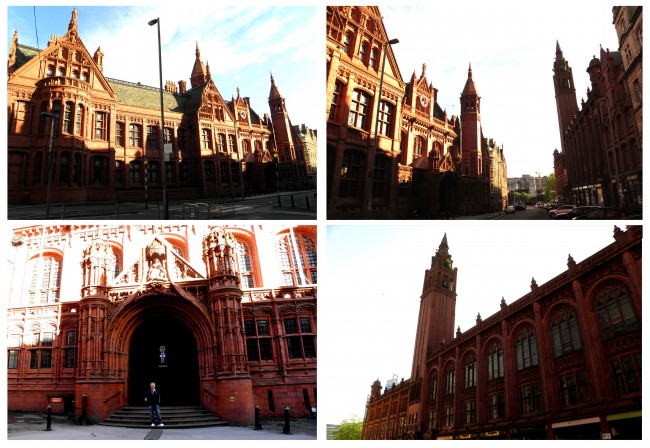
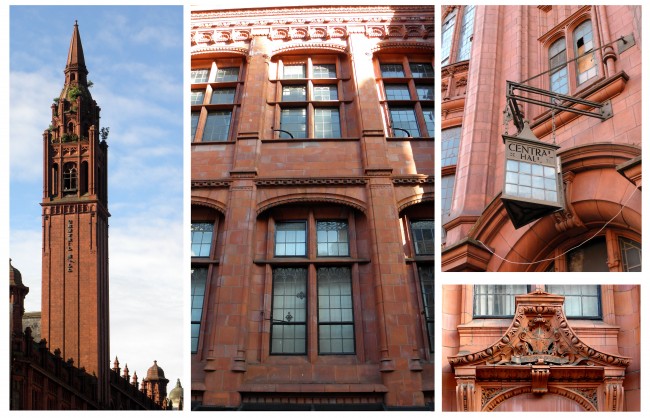
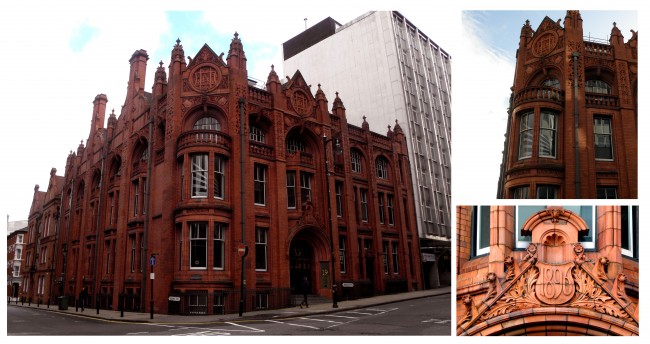
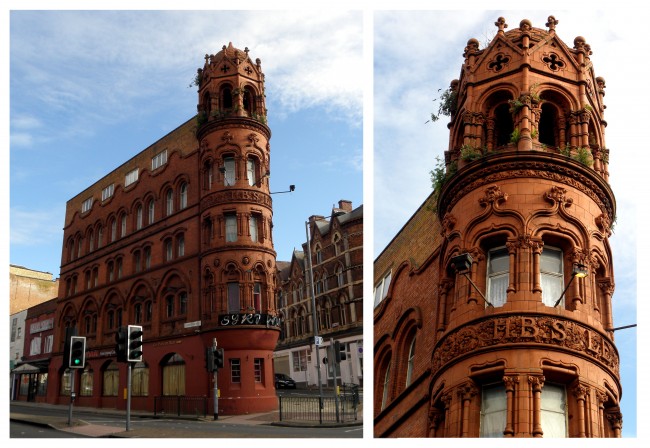
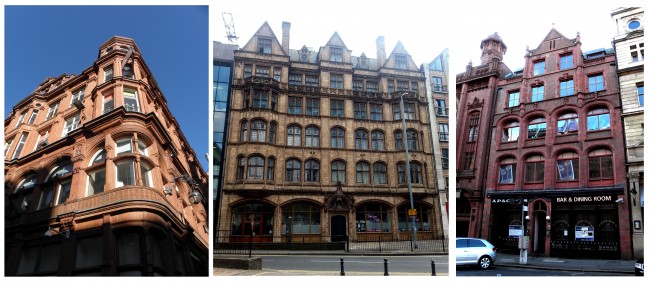
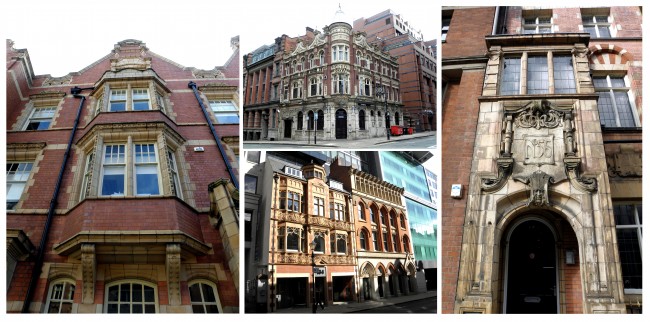
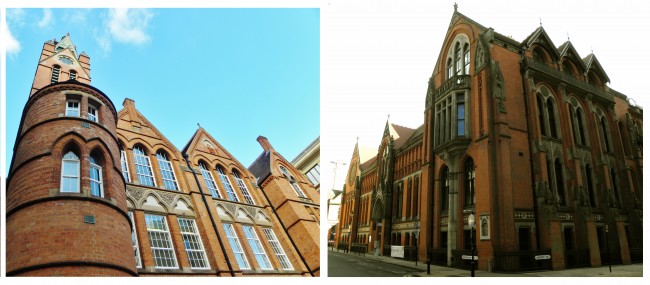

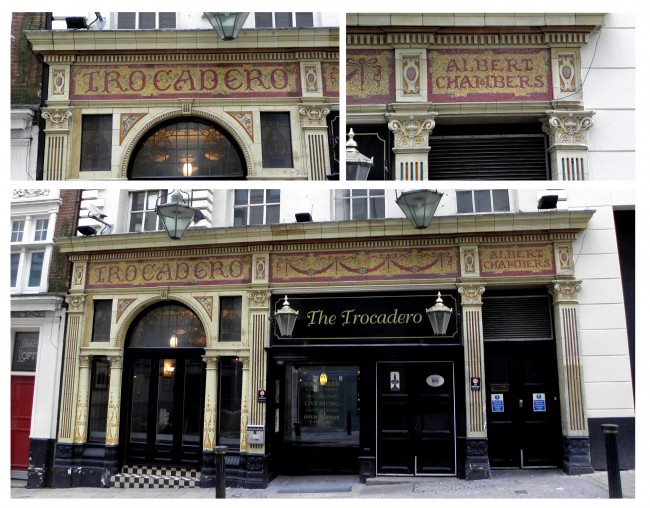
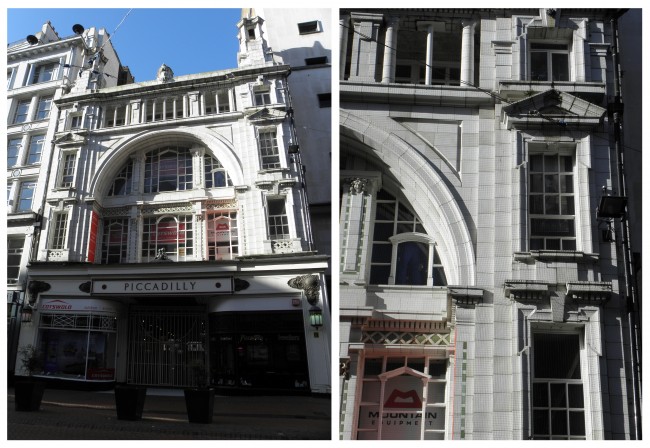
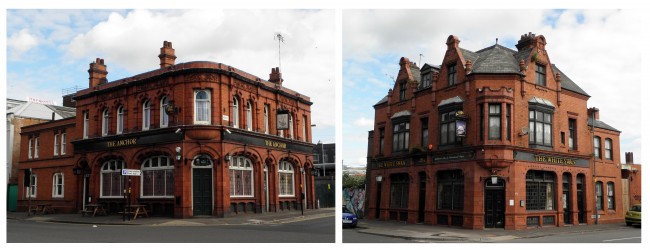
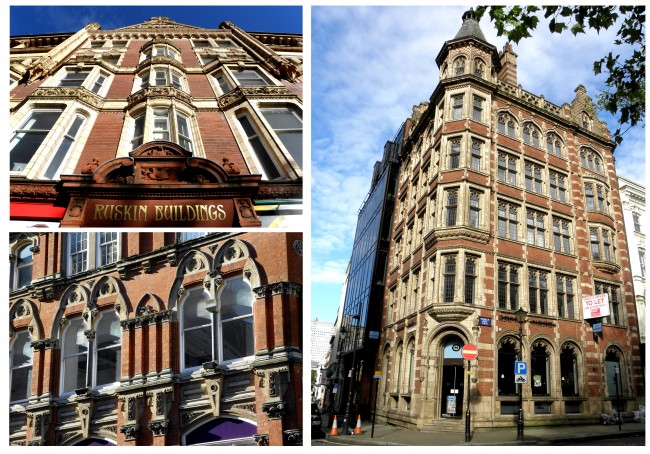
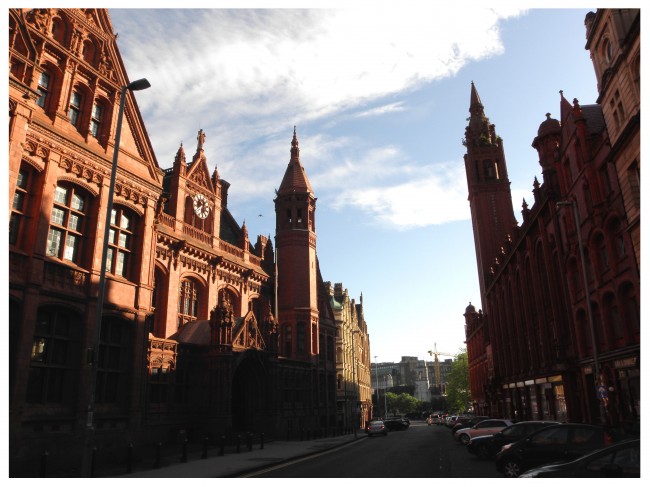

FABULOUS!
I just keep scrolling through the pictures and yes they take my breath away. Today designers thoughts are so different to those of yesterday but they built odd buildings in outstanding places and they stick out like a sore thumb…yesterday, buildings were brilliantly thought about and superbly built and one went along with another but….demolishing raised its head and ‘Birmingham’ chided big time. St Martins still holds its spot and yes draws people in she looks grand stands tall. I hoped some old beautiful buildings would have be left standing on show and the internal lay out changed but…..I know you can’t bring back what we have lost but us oldies are missing them…..